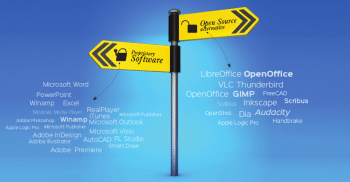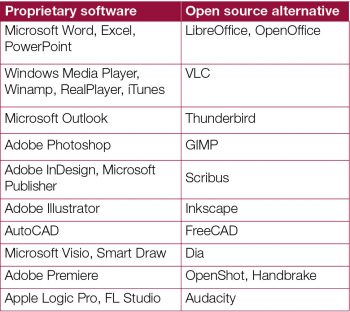Open source alternatives for commonly used proprietary software

Proprietary software is usually costly and its source code is known only to the company that produces and markets it. Open source software is usually free, and its source code is available to the user who is free to modify it. Here’s a list of open source software that can be used in place of commonly used proprietary tools.
Nowadays, a huge range of software is available for the desktop; some come pre-installed with the operating system and the rest can be downloaded from the Internet. Usage of the desktop differs from user to user, and so does the software requirement. This article explores the best open source alternatives for commonly used proprietary software on the desktop.
Before going ahead, we should understand the terms ‘proprietary software’ and ‘open source software’.
In simple words, proprietary software is owned by the company or publisher, and its source code is kept secret. People have to purchase this software to be able to use it. This could be a one-time payment or a recurring cost in case of subscription based models. A person can use the software but cannot view the source code or modify it.
Open source software, as the name suggests, has its source code made available to the user of the software. The user can modify the source code and redistribute it, giving due credits. Usually, all open source software allows the community to participate in development activities, bug-spotting and fixing, feature enhancement, etc. Many open source software publishers don’t charge people for using the software.
Let’s explore the different types of proprietary software and their open source alternatives.
Productivity software
The most commonly and frequently used proprietary software is Microsoft Office Suite, which consists of Word, Excel, PowerPoint, Access, Visio, OneNote, Publisher and Project. From the complete list of software in the suite, three draw special attention—Word, Excel and PowerPoint, as these are used by students, beginners and professionals. Most desktop users are familiar with Microsoft Word, Excel and PowerPoint for tasks like letter drafting, report writing, and making some calculations, charts or presentations. Microsoft Office is proprietary software. One needs to purchase it before being able to use it. It comes in many variants and each has a different price, starting from ₹ 4000 and going up to ₹ 30,000 or more. It is available for Windows and Mac platforms.
The best available alternative to Microsoft Office is LibreOffice and OpenOffice. Both are open source projects, community driven, cross platform, easy to use and intuitive. They are also compatible with Microsoft Office in terms of file formats.
Apart from LibreOffice and OpenOffice, AbiWord is also available as an alternative to Microsoft Word.
 Music and video playback
Music and video playback
Listening to music and watching videos is a common passtime. There is a lot of proprietary software available for music and video playback like Windows Media Player, iTunes, RealPlayer, Winamp, to name a few. None of these players are versatile enough to playback all the formats, nor are they cross platform.
The best alternative is to use VLC Media Player for video and audio playback. VLC is open source and cross platform. It not only does playback in any format, but also supports recording and streaming.
Organiser and mail management
Microsoft Outlook is a commonly used email application. It works best with Microsoft Exchange Server or Microsoft SharePoint Server. Apart from email, it supports calendar, tasks, contacts and browsing. Mozilla Thunderbird is the open source alternative that can replace the email application, and it also provides the features of the calendar and address book. It can be used on any platform and comes with many features, plugins and add-ons.
Designing and publishing
Adobe Photoshop is common software for anyone working with images, which includes editing and manipulating these. It is used by graphics artists, designers and photographers. It works well with raster images. The cost of Adobe Photoshop is approximately ₹ 26,000, and it runs on Windows and Mac.
The GIMP, which is cross platform and open source software, is the best open source alternative to Adobe Photoshop. Its learning curve is a bit steep but you can do impressive things with it in the long run.
Adobe InDesign and Microsoft Publisher are standard tools for creating layouts and publishing magazines, newspapers, flyers, pamphlets, banners, etc. Both are costly and proprietary software. Scribus is the best open source alternative tool to them. It supports all the required features for publishing.
Vector based art is used to create art work which can scale up or be resized without losing the clarity, for which Adobe Illustrator is used. It is clean, simple and used in creating clip art, print art, logo design, charts, line art, etc. It costs around ₹ 25,000. The open source alternative is Inkscape, which allows users to create vector art.
AutoCAD is another proprietary software used for modelling and designing a range of products. It is mostly used by architects, engineers and professionals to create 2D and 3D models. FreeCAD and Archimedes are open source alternatives to the costly AutoCAD.
Diagrams
Microsoft Visio and Smart Draw are the other common proprietary software used by students and professionals for drawing various diagrams like UML, ER, flowcharts, etc. Dia is the open source alternative for Visio and SmartDraw.
Video editing and rendering
Nowadays, creating video clips is very common due to the availability of camera phones. The concept of video blogging is also gaining momentum.
The creation of videos for YouTube and other platforms is on the rise. Once the video is ready, it requires software to edit and render it properly. Adobe Premiere CC or Pro are used for this, but they are costly and proprietary. OpenShot and Handbrake are the best open source alternatives being used by many professionals.
Audio recording and editing
Those in the music industry use many kinds of proprietary software to record and edit music, like Apple Logic Pro or FL Studio Producer Edition, which are both expensive. Audacity is open source software which allows you to record audio using a simple microphone, after which you can do all the professional tinkering you want to with the track.











